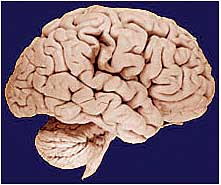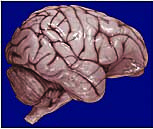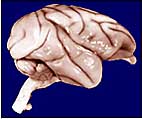Researchers identify genes involved in evolution of brain development
By Catherine GianaroMedical Center Public Affairs
 | |
 | |
 | |
 | |
 | |
 Bruce Lahn and his team of researchers studied the brains of a human (from top to bottom), chimpanzee, gibbon, macaque, squirrel monkey and tarsier, as well as the brains of a galago and a mouse (not shown). | |
Researchers have identified two genes implicated in the dramatic expansion of the human cerebral cortex—a development considered to be one of the hallmarks of human evolution.
The findings, which may partly account for the difference in brain size between humans and other primates, were published in two papers, in the Tuesday, Jan. 13 issue and the Friday, April 2 issue of Human Molecular Genetics.
The researchers, led by Bruce Lahn, Assistant Professor in Human Genetics, presented evidence that the pressure of natural selection has led to dramatic evolutionary changes in a gene called Microcephalin and another gene called ASPM. Both are known to control brain size during development in humans. Patrick Evans, Jeffrey Anderson, Eric Vallender, Sandra Gilbert, Christine Malcom, Steve Dorus and Sun Shim Choi, all seven of whom work in Lahn’s laboratory, were co-authors of the paper.
“People have studied the evolution of the brain for a long time, but they have traditionally focused on the comparative anatomy and physiology of brain evolution,” said Lahn, who also is an Assistant Investigator in the Howard Hughes Medical Institute. “I would venture, however, that there really hasn’t been any convincing evidence until now of any gene whose changes might have contributed to the evolution of the brain.”
The researchers decided to explore Microcephalin and ASPM because mutant forms of these genes cause primary microcephaly, a developmental defect that affects humans. This disorder is marked by a severe reduction in the size of the brain, particularly the cerebral cortex—the part of the brain responsible for planning, abstract reasoning and other higher brain functions. The brains of people with primary microcephaly are otherwise normal, and other structures of the body seem unaffected.
The researchers traced the evolution of Microcephalin and ASPM by comparing the genes’ sequences in a range of primates, including humans, as well as non-primate mammals. Specifically, the researchers sequenced the human, chimpanzee, gorilla, orangutan, gibbon, colobus monkey, squirrel monkey and lemur forms of the genes.
“We chose these species because they were progressively more closely related to humans,” said Lahn. “For example, the closest relatives to humans are chimpanzees, the next closest are gorillas, and the rest go down the ladder to the most primitive.”
The sequence of primates from human to lemur generally represents a progression from the most advanced to the more primitive. Chimpanzees are the closest, living genetic relative of humans, and the lemur represents the most primitive primate, having branched from the primate tree before the evolution of monkeys, apes and humans. To study the evolution of the genes in other mammals, the researchers also sequenced these genes from the dog, cat, cow, sheep, rat and mouse.
For each species, the researchers identified changes in both the Microcephalin and the ASPM genes that altered the structure of the resulting proteins, as well as those that did not affect protein structure. Only those genetic changes that alter protein structure are likely to be subject to evolutionary pressure, Lahn said. Changes in the gene that do not alter the protein indicate the overall mutation rate—the background of random mutations from which evolutionary changes arise. Thus, the ratio of the two types of changes gives a measure of the evolution of the gene under the pressure of natural selection.
“We were a bit surprised that, when we went from ASPM to Microcephalin, we saw a very similar pattern repeating itself, although not exactly the same,” said Lahn. “That is, we saw an acceleration in the evolution of the protein sequence throughout the lineage from simian ancestors to humans and chimpanzees.” However, said Lahn, while changes in the ASPM gene showed the most dramatic acceleration in the later lineage from ape ancestors to humans, the greatest acceleration in the evolution of the Microcephalin gene occurred early in the primate lineage.
“This provides strong evidence that the evolution of the Microcephalin gene is highly accelerated, specifically along the lineage leading to humans, but not necessarily in a terminal human branch,” said Lahn. “Acceleration has actually been more intense in the early part of this lineage—going from simian ancestors to apes.”
The researchers concluded that this difference could mean that Microcephalin was more involved in the earlier stages of evolution of primate brain size, while ASPM might have contributed more to brain expansion closer to the final evolutionary step to humans.
The researchers also compared the subtle variations in the Microcephalin and ASPM genes among humans, and found further evidence of an evolutionary pressure driving the changes in these genes.
Although the studies are preliminary, said Lahn, the evidence of evolutionary pressure on the two genes offers a hint at the basic mechanism by which the large human brain evolved. “Two genes don’t really make a trend,” he said. “But they certainly make it a tantalizing hypothesis that genes that control brain size or gross morphology during development will be disproportionately involved in brain evolution.”
The researchers are continuing their studies to determine the biological function of the two genes, to better understand how their mutation could have led to the characteristic enlargement of the human brain.
“We want to know when was the last time that the lightning of evolution struck either one of these genes during human evolution,” said Lahn. “Was it 100,000 years ago, or a million years ago or half a million years ago? That would be fascinating to know from the viewpoint of understanding the history of evolution of the human brain.”
![[Chronicle]](/images/sidebar_header_oct06.gif)